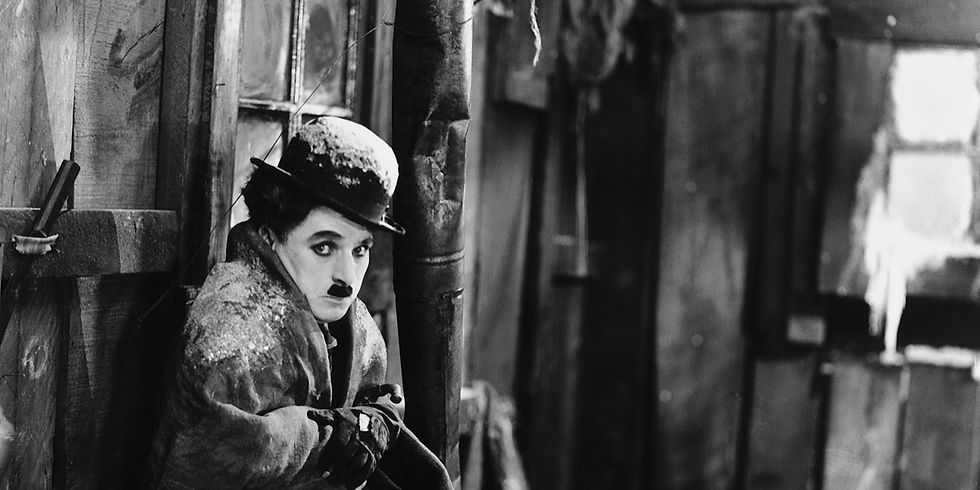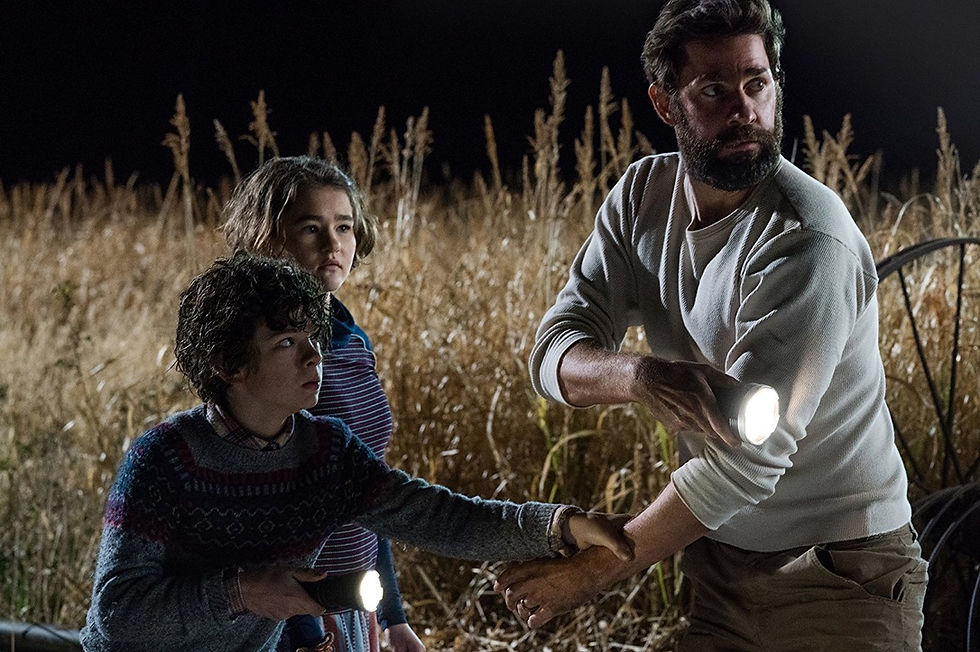When Words Fall Away: Unveiling the Profound Impact of Silence
- khailareyno
- Apr 23, 2024
- 6 min read
Updated: Apr 25, 2024

Charlie Chaplin (1915)
In screenwriting, silence is a deliberate choice made by the writer to allow the visuals, actions, and expressions of the characters to convey meaning without verbal communication. Silence can be used to create dramatic effect, build tension, highlight a character's emotions or inner thoughts, or simply to give the audience a moment to absorb and interpret what is happening on screen. It is a powerful tool that, when used effectively, can add depth and richness to a scene, enhancing the overall impact of the story.
Silence can also be used to convey complex emotions that may be difficult to express through words alone. For instance, consider a scene where a character is confronted with a shocking revelation. Their initial response might be silence, which can speak volumes about their inner turmoil and conflicting emotions. This silence can signify a range of feelings such as disbelief, confusion, or even a struggle to process the information. It allows the audience to witness the character's internal struggle without the need for explicit dialogue, fostering a deeper connection between the character and the audience.
Now, we will analyze the films "A Quiet Place" and its sequel "A Quiet Place Part II," both directed by John Krasinski, using the following techniques. In these movies, silence is a central element of the plot, as the characters must remain quiet to avoid being hunted by creatures with acute hearing.
A Quiet Place (2018)
Building Tension
Silence is an essential tool in film, especially in genres like thrillers and horror, where it can create suspense and tension. By removing dialogue and background music, silence can heighten the audience's focus, making them more aware of subtle sounds and movements on screen. This can build anticipation and make sudden events even more startling. In suspenseful moments, withholding dialogue or sound can keep the audience on the edge of their seats, creating a sense of unease and making the eventual payoff more satisfying.
"A Quiet Place" and "A Quiet Place Part II," are standout examples of using silence to masterfully build tension. In these films, silence is not just a stylistic choice but it is crucial to the plot, as the characters must remain silent to avoid creatures with hyper-sensitive hearing. This reliance on silence creates a constant sense of unease and vulnerability, as every noise – from a creaking floorboard to a dropped object – could lead to deadly consequences. It creates a heightened sense of awareness, as the audience is acutely attuned to even the slightest noise, mirroring the characters' own heightened senses.
Enhancing Emotional Impact
In emotional scenes, silence serves as a potent tool to convey the depth of characters' feelings. By avoiding the use of dialogue, the focus shifts to their actions and expressions, allowing the audience to witness the raw intensity of their emotions. For example, a character's silent, tearful moment can be profoundly moving, as the absence of words highlights the depth of their sorrow or joy. In these moments, silence speaks volumes, drawing the audience into the character's emotional world and fostering a deeper connection. It allows viewers to empathize with the character's pain or happiness in a way that words alone often cannot achieve.
In "A Quiet Place" and "A Quiet Place Part II," silence is not merely a storytelling device; it is a fundamental aspect of the characters' emotional journeys and the overall impact of the films. The use of silence enhances the emotional impact of key moments by allowing the audience to focus solely on the characters' actions and expressions, rather than being distracted by dialogue or music. This minimalist approach forces the audience to connect more deeply with the characters, as they must rely on visual cues and subtle nuances to understand their emotions and motivations.
For example, in the first film, there is a powerful scene where the mother character, Evelyn, played by Emily Blunt, must give birth in complete silence to avoid attracting the creatures. The absence of sound in this scene amplifies the tension and desperation of the moment, while also highlighting Evelyn's strength and determination. Similarly, in "A Quiet Place Part II," there are several emotional moments where characters must convey complex feelings without speaking.
A Quiet Place (2018)
Highlighting Key Moments
Silence is a powerful cinematic tool that can be used to emphasize important moments in a film. By removing all sound, the audience's attention is solely focused towards what is unfolding on screen, heightening the impact of the moment. This technique can be particularly effective in drawing attention to a crucial piece of information or a character's reaction to a significant event. For example, in a suspenseful scene where a character discovers a shocking truth, the absence of sound can amplify the tension and drama of the moment, allowing the audience to fully absorb the gravity of the situation. Similarly, in a scene where a character is processing a profound realization, the use of silence can underscore the emotional weight of the moment, creating a powerful and memorable cinematic experience.
One way the films achieve this element is by contrasting moments of silence with moments of sound. For example, there is a scene where the characters are walking on a path made of sand to muffle their footsteps. The silence of their movements is suddenly broken by the sound of a toy spacecraft, which alerts the creatures to their presence. This sudden shift from silence to sound creates a jarring and impactful moment that highlights the danger the characters are facing. Silence draws attention to these pivotal moments, intensifying their impact and significance in the story.
Creating Atmosphere
Silence plays a crucial role in setting the mood and atmosphere of a scene in film. In a quiet, peaceful setting, silence can convey a sense of calm and tranquility, allowing the audience to immerse themselves in the beauty of the moment.
Conversely, in a tense or eerie setting, silence can be used to create a sense of unease and foreboding. By removing all sound, the audience is left with a sense of anticipation, as they are unsure of what might happen next. This use of silence can build suspense and tension, heightening the audience's emotional response to the scene.
The use of silence also plays a crucial role in creating the atmosphere in the films. The quietness of the world contributes to a sense of isolation and desolation, emphasizing the characters' struggle to survive in a hostile environment. This sense of isolation adds to the overall atmosphere of tension and dread, creating a palpable sense of unease that lingers throughout both films.
Character Development
How a character responds to silence can reveal significant aspects of their personality and emotional state. For instance, a character who embraces silence might be depicted as introspective or contemplative, suggesting a deep inner world and a penchant for thoughtful reflection. Conversely, a character who is uneasy with silence might be portrayed as restless or anxious, hinting at a discomfort with reflection or a craving for constant activity. This contrast in reactions to silence can serve as a powerful tool for character development, allowing audiences to glean insights into the characters' innermost thoughts and feelings.
The films utilize silence to deepen character development in profound ways. With limited dialogue, the characters must rely heavily on nonverbal communication. Their actions and reactions are an essential in revealing their personalities, relationships, and motivations. This allows for nuanced and complex character development, as the audience gains insight into the characters' inner lives through their behaviour in the face of silence and danger.
For example, in "A Quiet Place," the character of Lee Abbott, portrayed by John Krasinski, is depicted as a loving and protective father. Through his actions and expressions, rather than through words, the audience learns about his dedication to his family and his unwavering determination to keep them safe. Similarly, in "A Quiet Place Part II," the character of Regan Abbott, played by Millicent Simmonds, undergoes significant growth and development. Her journey is conveyed not through dialogue but through her actions and interactions with other characters, showcasing her strength, resilience, and determination to survive in a dangerous world.

A Quiet Place (2018)
Silence stands as a fundamental element in screenwriting, serving as a versatile tool that enhances various aspects of storytelling. It effectively builds tension by creating a sense of anticipation and unease, leading to gripping narratives. It enhances the emotional impact of scenes by allowing audiences to focus on characters' actions and expressions, deepening their connection with the story. Furthermore, it highlights key moments, drawing attention to pivotal events and decisions that shape the plot. Additionally, silence also plays a crucial role in creating atmosphere, setting the tone and mood of a scene to immerse audiences in the story's world. Lastly, silence contributes significantly to character development, revealing personalities, relationships, and motivations through nonverbal cues. Overall, silence is essential in screenwriting, offering a powerful means to engage audiences, evoke emotions, and craft compelling narratives that resonate long after the credits roll.


